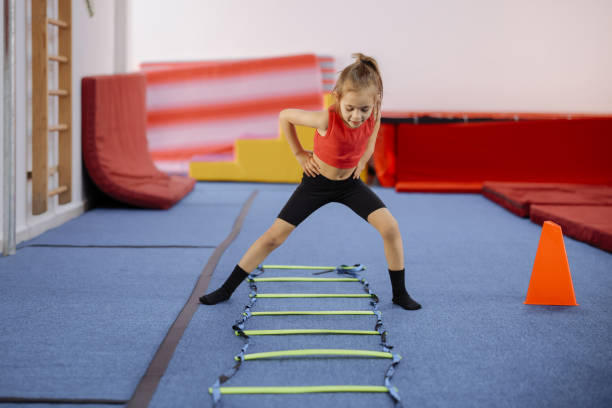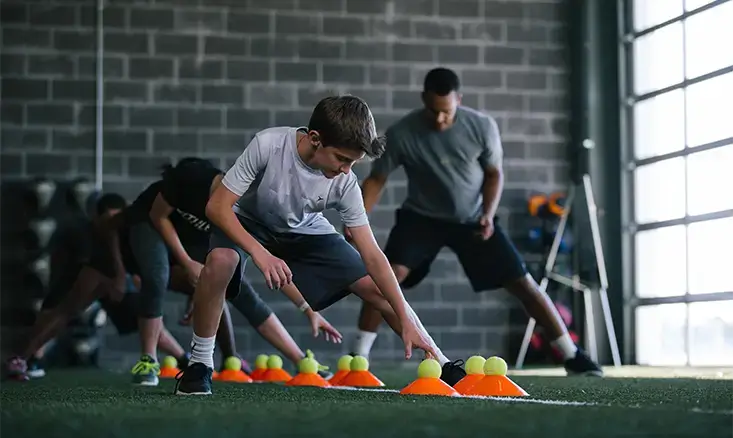Indoor soccer workouts for youth players aren’t just a way to stay active during the colder months; they’re a bridge that keeps young athletes connected to the game they love, even when the fields are frozen and the days are short.
Soccer doesn’t pause for the weather, not really. For kids who live to move, to chase, to feel the ball at their feet, the joy of play doesn’t belong to a season. It belongs to routine, to rhythm, to finding small ways to keep improving, no matter the space or time of year.
For many families, the challenge starts when outdoor practices end. Games stop, coaches take a break, and suddenly the hours that were filled with soccer become empty. Yet children still need at least an hour of daily activity to stay healthy, focused, and happy. The good news is that with a bit of creativity, soccer training can fit inside the home.
Living rooms, basements, garages, or even hallways can transform into training grounds where kids build balance, strength, and sharper footwork; all through simple, fun exercises.
These indoor workouts aren’t meant to replace the open field. They’re meant to keep kids engaged, confident, and prepared for the next season. Every controlled touch, every playful repetition, strengthens not just the body but the relationship between a young player and the ball.
The goal is to make practice feel less like a chore and more like a game, something they look forward to doing every day.
Be it your child dreams of playing at higher levels or simply loves the sound of a ball rolling across the floor, indoor soccer workouts can help them stay active and keep improving, all within the comfort of home.
What follows are some of the most effective, space-friendly drills and activities designed for kids of all ages to train anywhere, anytime.
The Value of Indoor Training
Many parents worry that indoor drills can’t replicate the intensity or structure of field training. But when it comes to young players, the focus should always be on touches, balance, coordination, and fun. The field will be there in the spring.
What matters now is maintaining the connection between the child and the ball.
Every touch helps them grow. Repetition is the quiet key to soccer development. It’s what builds instinct.
A player who has spent the winter with a ball at their feet; learning to control, roll, and strike it even in small spaces, will step back onto the field in better shape than when they left.
CHECK OUT | What to Pack for Summer Soccer Camp: Must-Have Items for Players
Creating a Safe Indoor Space
Before any drill begins, make sure the environment is safe. Clear an area free of fragile items. A futsal ball (a smaller, low-bounce version of a soccer ball) is ideal for indoor practice. It stays on the ground more easily and reduces the risk of wild ricochets.
You don’t need much space, a few yards of open floor will do.
Tape lines can substitute for cones. A small rug can mark out a dribbling course. What matters most is giving your young player room to move freely without fear of knocking something over.
Once that’s set, it’s time to play.
Cone Dribbling

Few drills build ball control better than cone dribbling. It’s simple, adaptable, and endlessly challenging.
You’ll need a few cones (or substitutes plastic cups or shoes work fine) and a soccer or futsal ball. Place the cones about a foot apart in a straight line or small triangle.
The goal is to weave the ball around them using different parts of the foot; inside, outside, sole without losing control.
Start slow. Let your child get comfortable with how the ball moves. Once the rhythm settles, you can add time challenges or pattern variations.
Try zigzag dribbling one round, then figure-eights the next. The more variation, the better.
Parents can make this fun by keeping track of personal bests. Maybe it’s the fastest time through the cones or the most consecutive rounds without hitting one. A simple whiteboard or notebook can turn this into a mini competition.
As they grow stronger, reduce the space between cones to demand more precision.
The real magic of this drill lies in repetition. It teaches control in tight areas, the same control that helps players escape defenders or change direction quickly on the field.
Push-Pull Drills
If there’s one drill that connects ball control and muscle memory, it’s the push-pull.
Have your child place one foot on top of the ball. Roll it backward toward the heel, then push it forward again toward the toe. Do this repeatedly, keeping the ball close. Encourage a light hop on the standing foot to mimic real movement.
This exercise builds rhythm and strengthens the small muscles in the feet and ankles that handle ball control during games.
Once your child masters the motion, introduce a twist: switch feet after every few reps, then challenge them to complete 100 reps per foot within a minute. It becomes a fun, fast-paced challenge that keeps them engaged.
For an extra challenge, try using different-sized balls, like a tennis ball or small rubber ball. The smaller the ball, the greater the precision required.
The push-pull is a quiet powerhouse of a drill. It doesn’t take much space, but the effect on control and confidence is significant.
CHECK OUT | 10 Best Soccer Drills for Solo Practice and Skill Improvement
Toe Taps
Toe taps are a staple of soccer training. They work on coordination, agility, and cardiovascular endurance all at once.
Place the ball in front of your child. Have them lightly tap the top of the ball with alternating feet, staying light on their toes. It starts slow, then builds in tempo until it becomes a rhythmic, bouncing motion.
The key is to touch the ball gently without putting too much weight on it. With practice, the movement becomes smoother, and the player’s heart rate climbs, a great mini cardio workout.
Once they’re comfortable, make it mobile. Have them move the ball forward, backward, or side to side while maintaining the taps. This builds balance and adaptability.
To keep it engaging, try mini challenges:
- How many taps can they do in 30 seconds?
- Can they keep the rhythm for an entire song?
Even a few minutes of toe taps each day can improve footwork and overall conditioning.
Wall Passes
If you have a solid wall in your home or even a sturdy garage wall, use it for wall passes. This simple exercise mimics the give-and-go technique that players use constantly in real games.
Stand a few feet away from the wall. Pass the ball against it using the inside of the foot and control the rebound. Start with gentle passes, focusing on accuracy.
The rhythm of pass-and-control teaches first touch and body positioning. It also builds awareness of timing, one of the most overlooked skills in youth soccer.
As your child improves, increase the distance or alternate feet. Add movement by shuffling side to side between passes.
You can make this a solo challenge or join in as a parent. Kids love seeing their parents kick a ball with them, it builds connection as much as skill.
CHECK OUT | How to Prevent Burnout in Female Soccer Players: 10 Helpful Tips
Cardio Circuit Training
Soccer fitness isn’t just about ball work. Players need endurance, agility, and explosiveness. Indoor circuit training is a perfect way to build those qualities without needing a field.
Create a simple circuit with four to six stations. Each station should focus on a different aspect of fitness. Here’s a sample routine:
- High Knees – 30 seconds of driving knees up quickly while jogging in place.
- Butt Kicks – Quick jogging while kicking heels up to touch the back.
- Jumping Jacks – A full-body warm-up that builds rhythm.
- Burpees – Combine squats, push-ups, and jumps for total conditioning.
- Alternating Foot Hops – Jump side to side from one foot to the other for balance and core strength.
Start with 30 seconds per exercise, then rest for 20 seconds. Repeat the circuit three or four times, depending on age and fitness level.
Make it a family activity. Parents can join in, creating a shared workout routine that keeps everyone active. Kids thrive when they see adults participating, it makes the effort feel like play.
Over time, increase the intensity by shortening rest periods or adding light weights (like a backpack with a few books).
Agility Ladder Work

An agility ladder is a simple but powerful training tool. If you don’t have one, tape lines on the floor about a foot apart.
The goal is to move quickly and precisely through the “rungs,” using short, controlled steps. Start with basic movements; one foot in each space, then two feet in each, then side steps.
For soccer players, these drills improve coordination, balance, and explosive footwork. They also sharpen the brain’s connection to the body, enhancing reaction speed.
You can make agility ladder sessions fun by turning them into mini races or rhythm games. Try playing music and having your child match their steps to the beat.
CHECK OUT | Youth Soccer Passing Warm-Up Drill for Better Team Play
Core Strength and Balance
A strong core helps players stay upright during tackles and hold balance when changing direction. Indoor training is the perfect time to build it.
Simple exercises go a long way:
- Planks – Hold for 30 seconds to start, gradually increasing to a minute.
- Side Planks – Strengthens obliques and hips.
- Mountain Climbers – Builds endurance and mimics the dynamic movement of soccer.
- Single-Leg Stands – Balance on one foot while passing or rolling the ball under the other.
Core strength supports every motion a soccer player makes. It’s not just about power—it’s about control.
Juggling
Few exercises teach touch and patience like juggling. It’s one of those quiet skills that separates the confident from the cautious.
Start small. Encourage your child to juggle with one bounce between touches if needed. Alternate feet, use thighs, or even the head once they’re comfortable.
Juggling teaches timing, precision, and focus. Even five minutes a day adds up quickly. Keep a running record of their highest juggle count, it’s a simple way to track progress and keep motivation high.
Passing Accuracy Challenge
Turn a rainy afternoon into a skills challenge. Set up small targets like empty water bottles or soft toys, and have your child try to hit them with accurate passes.
This teaches precision over power. Young players often focus on how hard they can kick, but true development comes from controlled, accurate movement.
As accuracy improves, move the targets farther away or make them smaller.
CHECK OUT | How to Run a Perfect 7v7 Soccer Scrimmage for Youth Teams
Fitness Games for the Whole Family
Soccer training doesn’t have to feel like training. Sometimes the best sessions are hidden inside simple games.
Try setting up small challenges like:
- Ball tag – one player tries to tag the others using a soft pass.
- Obstacle course – cones, cushions, and chairs can make creative dribbling paths.
- Simon Says Soccer – call out commands like “left foot dribble” or “three toe taps.”
Games like these keep energy high and attention focused without feeling repetitive.
Building a Routine
Consistency is what keeps progress alive. Help your child set small, daily goals. Even 15–20 minutes of focused indoor training each day can make a noticeable difference by the time spring arrives.
Create a simple schedule, maybe a mix of ball control on Monday, cardio on Tuesday, rest on Wednesday, and so on. Keeping it varied prevents burnout and maintains enthusiasm.
Encourage them to take ownership of their training.
Let them choose drills, set challenges, and track improvement. It builds responsibility and self-motivation, qualities that extend far beyond sports.
CHECK OUT | Fun and Competitive 4v4 Soccer Drill with Small Gates
Staying Positive Through the Off-Season
Winter can feel long, especially for kids who live for outdoor play. Indoor training gives them an outlet, a way to keep their energy focused and their spirits high.
Celebrate the small victories. The first time they complete a hundred toe taps without stopping. The day they hit ten juggles in a row. Those moments are fuel.
It’s also important to keep balance. Encourage rest days, stretches, and mindful breaks. Growing athletes need time to recover.
When Spring Returns
When the snow finally melts and fields open again, you’ll notice something special. The first touches will feel smoother.
Their movements sharper. The habits built in those small indoor sessions translate directly to the field.
Your child will run with a little more confidence, knowing they’ve worked through the off-season when others rested.
That quiet work becomes visible in every pass, every dribble, every goal.



